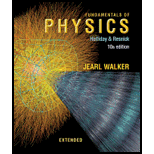
Concept explainers
In a first experiment, a sinusoidal sound wave is sent through a long tube of air. transporting energy at the average rate of Pavg, 1· In a second experiment, two other sound waves, identical to the first one, are to be sent simultaneously through the tube with a phase difference ϕ of either 0, 0.2 wavelength, or 0.5 wavelength between the waves, (a) With only mental calculation, rank those choices of ϕ according to the average rate at which the waves will transport energy, greatest first, (b) For the first choice of ϕ, what is the average rate in terms of Pavg, 1?
To find:
a) The rank of phase difference according to the average rate of transport of energy by the waves, greatest first.
b) The average rate of energy transport for the first choice in (a).
Answer to Problem 1Q
Solution:
a) The rank of phase difference according to the average rate of transport of energy by the waves, greatest first, is
b) The average rate of energy transport for (a)
Explanation of Solution
1) Concept:
The rate of energy transported by a travelling wave depends on the intensity of the wave as well as the area to which the energy is transported. The intensity of a resultant wave depends on the phase difference between the two superposing waves.
2) Formula:
3) Given:
i) The average rate of energy transported by a single wave =
ii) The phase difference between the two waves sent through the pipe are
4) Calculations:
a) The rate of energy transported is given by
When two waves are sent with phase difference
Thus, the rate of energy transport for
When two waves are sent with phase difference
Hence, the resultant intensity will be more than the single wave but less than that for
When two waves are sent with phase difference
Hence, the ranking of the situations will be
b) Since the amplitude of the resultant wave is twice the single wave, intensity is four fold. Hence, the rate of energy transported will be
Conclusion:
The energy transported by a wave can be calculated by using the intensity of the wave. Here, the intensity changes according to the phase difference between the two superposing waves. Hence the rate of energy transported changes as the phase difference changes.
Want to see more full solutions like this?
Chapter 17 Solutions
Fundamentals of Physics Extended
Additional Science Textbook Solutions
Cosmic Perspective Fundamentals
Microbiology: An Introduction
Biology: Life on Earth (11th Edition)
Microbiology: An Introduction
College Physics: A Strategic Approach (3rd Edition)
Principles of Anatomy and Physiology
- 20. Two small conducting spheres are placed on top of insulating pads. The 3.7 × 10-10 C sphere is fixed whie the 3.0 × 107 C sphere, initially at rest, is free to move. The mass of each sphere is 0.09 kg. If the spheres are initially 0.10 m apart, how fast will the sphere be moving when they are 1.5 m apart?arrow_forwardpls help on allarrow_forwardpls help on thesearrow_forward
- pls help on all asked questions kindlyarrow_forwardpls help on all asked questions kindlyarrow_forward19. Mount Everest, Earth's highest mountain above sea level, has a peak of 8849 m above sea level. Assume that sea level defines the height of Earth's surface. (re = 6.38 × 106 m, ME = 5.98 × 1024 kg, G = 6.67 × 10 -11 Nm²/kg²) a. Calculate the strength of Earth's gravitational field at a point at the peak of Mount Everest. b. What is the ratio of the strength of Earth's gravitational field at a point 644416m below the surface of the Earth to a point at the top of Mount Everest? C. A tourist watching the sunrise on top of Mount Everest observes a satellite orbiting Earth at an altitude 3580 km above his position. Determine the speed of the satellite.arrow_forward
- pls help on allarrow_forwardpls help on allarrow_forward6. As the distance between two charges decreases, the magnitude of the electric potential energy of the two-charge system: a) Always increases b) Always decreases c) Increases if the charges have the same sign, decreases if they have the opposite signs d) Increases if the charges have the opposite sign, decreases if they have the same sign 7. To analyze the motion of an elastic collision between two charged particles we use conservation of & a) Energy, Velocity b) Momentum, Force c) Mass, Momentum d) Energy, Momentum e) Kinetic Energy, Potential Energyarrow_forward
 Principles of Physics: A Calculus-Based TextPhysicsISBN:9781133104261Author:Raymond A. Serway, John W. JewettPublisher:Cengage Learning
Principles of Physics: A Calculus-Based TextPhysicsISBN:9781133104261Author:Raymond A. Serway, John W. JewettPublisher:Cengage Learning University Physics Volume 1PhysicsISBN:9781938168277Author:William Moebs, Samuel J. Ling, Jeff SannyPublisher:OpenStax - Rice University
University Physics Volume 1PhysicsISBN:9781938168277Author:William Moebs, Samuel J. Ling, Jeff SannyPublisher:OpenStax - Rice University Physics for Scientists and Engineers: Foundations...PhysicsISBN:9781133939146Author:Katz, Debora M.Publisher:Cengage Learning
Physics for Scientists and Engineers: Foundations...PhysicsISBN:9781133939146Author:Katz, Debora M.Publisher:Cengage Learning Physics for Scientists and Engineers, Technology ...PhysicsISBN:9781305116399Author:Raymond A. Serway, John W. JewettPublisher:Cengage Learning
Physics for Scientists and Engineers, Technology ...PhysicsISBN:9781305116399Author:Raymond A. Serway, John W. JewettPublisher:Cengage Learning An Introduction to Physical SciencePhysicsISBN:9781305079137Author:James Shipman, Jerry D. Wilson, Charles A. Higgins, Omar TorresPublisher:Cengage Learning
An Introduction to Physical SciencePhysicsISBN:9781305079137Author:James Shipman, Jerry D. Wilson, Charles A. Higgins, Omar TorresPublisher:Cengage Learning College PhysicsPhysicsISBN:9781938168000Author:Paul Peter Urone, Roger HinrichsPublisher:OpenStax College
College PhysicsPhysicsISBN:9781938168000Author:Paul Peter Urone, Roger HinrichsPublisher:OpenStax College





